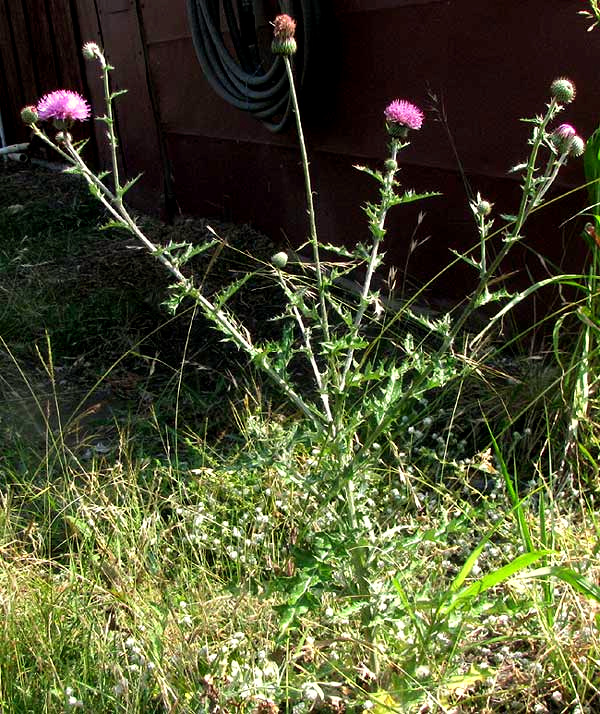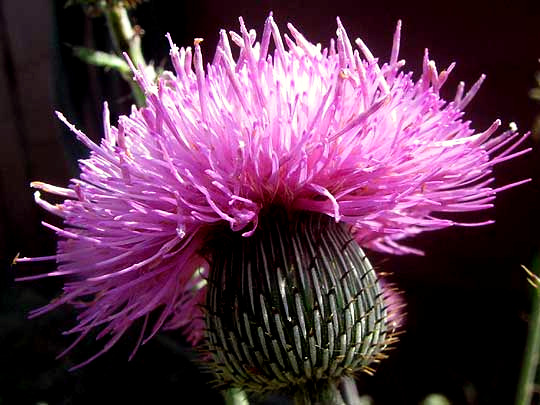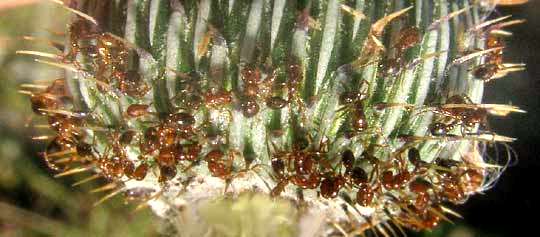Excerpts from Jim Conrad's
Naturalist Newsletter

from the May 26, 2013 Newsletter issued from the Frio Canyon Nature Education Center in northern Uvalde County, southwestern Texas, on the southern border of the Edwards Plateau; elevation ~1750m (~5750 ft); N29.62°, W99.86°; USA
TEXAS THISTLES
Last week we looked at the Nodding Thistle, an invasive from the Old World much despised by ranchers and farmers. There's another thistle common here in the grassy area around the cabin and along roads, and I've been looking forward to identifying it. For, most thistles you run into are weedy and people only want to get rid of them. However, in this area we have so many rare endemics that I thought the one around the cabin might be one of those native thistles of such limited distribution and finely tuned adaptations to local conditions that it can only be classified as a wildflower. Above you can see a knee-high one next to my laundry shed.
A close-up of a head with the bottom green, spiny part -- the involucre -- a bit smaller and more spherical that the involucres of most thistle species, and with unusually short, fine spines sticking out at right angles is shown below:

That picture also shows a feature that's fairly uncommon among the thistles, and that is that the individual bracts of the involucre, the phyllaries, each bear a conspicuous silvery strip down their middles -- a "prominent glutinous ridge," as the Flora of North America calls it. As soon as I saw this, already I had a feeling that this species was something special, not a rank invasive weed.
Some of our most aggressive weed thistles have their leaf margins continuing down the stem as narrow "wings." However, this thistle's leaf bases bore spiny ears that wrapped around the hairy stems, as shown below:

Also in that picture, note that leaf undersurfaces are white with wooly hairs.
So, when I "did the botany," this thistle species did indeed reveal itself as a wildflower and not a weed. It goes by such names as the Texas, Southern and Purple Thistle. It's CIRSIUM TEXANUM, native to northern Mexico's Chihuahuan Desert, extending into the US from New Mexico across the plains of Texas and southern Oklahoma to southwestern Arkansas and southwestern Louisiana. Its original habitat was deserty savannas but now it also finds what it needs along roadsides, in pastures and fields.
This is a fine species, one from which pollinators such as bees take plenty of nectar. Larvae of Painted-lady Butterflies feed on the leaves and finches of different kinds crave the thistle seed.
from the May 26, 2013 Newsletter issued from the Frio Canyon Nature Education Center in northern Uvalde County, southwestern Texas, on the southern border of the Edwards Plateau; elevation ~1750m (~5750 ft); N29.62°, W99.86°; USA
TEXAS THISTLE'S FLYPAPER STRATEGY
Above we mentioned the "prominent glutinous ridge" running down the back of each scale-like bract, or phyllary, covering the green, cuplike involucres constituting the greenish, spiny bottom part of each Texas Thistle flower head.
Glutinous means sticky, but I didn't realize how sticky the phyllary ridges were until I got close enough to see what appeared to be reddish debris accumulated among the spines at the bottom of some of the flower heads. Below you can see a close-up of that debris field:

Those are ants -- invasive, misery-causing, ground-nesting-bird-killing fire ants, and none of them appeared to be moving. I thought that maybe they were eating the scales' glutinous stuff, so I snipped off a thistle head and put it below the objectives of our dissecting scope. What I saw was appalling, even knowing that these were awful fire ants. It was like a battlefield with corpses frozen in grotesque, inexplicable poses, a mad frenzy of legs, antennae and thistle spines, but completely unmoving, everything dead. Below you can see a random view of the carnage, with fire ant legs and body parts lethally adhering to the phyllaries' glutinous ridges:

So here's a defense against nectar robbers who approach the thistle's nectar-rich flowering heads from below. Spines further keep grazing herbivores from nibbling the heads from above. Probably chemicals in the leaves prevent certain insects from eating them, too.